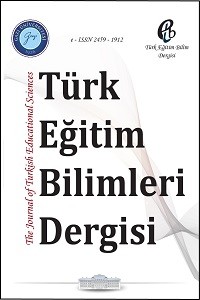Çevrimiçi Ders Süreçlerinde Farklı Konumlandırılan Benzeşimlerin Öğrencinin Akademik Başarısına ve Kalıcılığına Etkisi
Öz
Bu araştırmanın amacı, çevrimiçi öğrenme ortamlarında
farklı konumlandırılan benzeşimlerin öğrenenlerin akademik başarıları ve
öğrendiklerinin kalıcılıklarına etkisini belirlemektir. Araştırmada faktöriyel
desen kullanılmıştır. Araştırmanın çalışma grubu Ankara Üniversitesi Elmadağ
Meslek Yüksek Okulu Bilgisayar Teknolojileri Bölümü 2011-2012 eğitim öğretim
yılı Bahar dönemi “Ağlarda Veri İletişimi 1” dersini seçen 93 kişiden oluşmuştur.
Öğrencilere 4 farklı çevrimiçi öğrenme ortamı sunulmuş, öğrenenler bu ortamlara
rastgele seçim yöntemine göre atanmışlardır. Ortam 1, Ortam 2 ve Ortam 3 de
çalışan öğrenenlerin akademik başarı puanları Ortam 4 de çalışan öğrenenlere
göre artış göstermiş ancak kendi aralarında anlamlı bir farklılık bulunamamıştır.
Ortam 1, Ortam 2 ve Ortam 3 de çalışan öğrenenlerin kalıcılık puanları Ortam 4
de çalışan öğrenenlere göre artış göstermemiştir
Anahtar Kelimeler
Çevrimiçi Öğrenme Etkileşim Benzeşim Akademik Başarı Kalıcılık
Kaynakça
- Ausubel, D. P. (1968). Educational psychology: A cognitive view. New York: Holt, Rinehart & Winston.
- Clark, R. (2000). Evaluating Distance Education: Strategies and Cautions. Quarterly Review of Distance Education ,1, 3-16.
- Coppola, N. W. (2005). Changing roles for online teachers of technical communication. In C. H. Sides (Series Ed.) & K. C. Cook & K. Grant-Davie (Vol. Eds.), Online education: Global questions, local answers (pp. 89-99). Amityville, NY: Baywood.
- Curtis, R. V. and Reigeluth, C. M. (1984). The use of analogies in written text. Instructional Science, 13, 99-117.
- Çakır, H., Uluyol, Ç. ve Karadeniz, Ş. (2008). Öğretim stratejileri., H.İ. Yalın (Editör). İnternet Temelli Eğitim. (1. Basım). Ankara. Nobel Akademi Yayınevi. 65-105.
- Gentner, D. and Holyoak, K. J. (1997). Reasoning and learning by analogy: Introduction. American Psychologist, 52, 32-34.
- Gilbert, L. and Moore, D. R. (1998). Building interactivity into web courses: Tools for social and instructional interaction. Educational Technology, 38(3), 29-35.
- Gunawardena, C. N. and McIsaac, M. S. (2004). Distance education. Handbook of research for educational communications and technology, Mahwah, NJ: Lawrence Erlbaum Associates 2: 355-395
- Heywood, D. (2002). The place of analogies in science education. Cambridge Journal of Education, 35, 233-247
- Jung, I. (2011). The dimensions of e-learning quality: from the learners perspective. Education Technical Research Development, 59, 445-464.
- Kalyuga, S. (2007). Enhancing instructional efficiency of interactive e-learning environments: a cognitive load perspective. Educational Psychol Review, 19, 387-399.
- Kearney, M. and Young, K. (2007). An emerging learning design based on analogical reasoning. Proceedings of the 2nd International LAMS Conference, 51-61.
- Lawwill, K.S. (1999). Using writing to learn strategies: Promoting peer collaboration among high school science teachers. Ph.D Thesis, Faculty of Virginia Polytechnic Institue.
- Mayer, B. (1987). The dynamics of power in mediation and negotiation. Conflict Resolution Quarterly, 16, 75-86.
- Moore, M. G. (1989). Three types of interactions. The American Journal of Distance Education, 3(2), 1-6.
- Moore, M. G. (2007). The theory of transactional distance. In M. G. Moore (Ed.), Handbook of distance education, 2nd ed., 89–104. Mahwah, NJ: Erlbaum.
- Moore, M. G., and Kearsley, G. (1996). Distance education: A systems view. Boston, MA: Wadsworth Publishing.
- Moore, M. G. and Kearsely, G. (2005). Distance education: A systems view, 2nd ed. Thomson/Wadsworth
- Nguyen D.-D. and Kira D.S. (2000). Summative and Formative Evaluations of Internetbased Teaching. In L. Lau (ed.) Distance Learning Technologies: Issues, Trends and Opportunities, Hershey, PA: Idea Group Publishing.
- Paris, N. A., and Glynn, S. (2004). Elaborate analogies in science text: tools for enhancing preservice teachers knowledge and attitudes. Contemporary Educational Psychology, 29, 230–247.
- Reigeluth, C. M. and Stein, F. S. (1983). The Elaboration Theory of Instruction. In C. M. Reigeluth (ed), Instructional Design Theories and Models: An Overview of their Current States. Hillsdale, NJ: Lawrence Erlbaum.
- Schrum, L. (2000). Online teaching and learning: Essential conditions for success. In L. Lau (Ed.), Distance learning technologies: Issues, trends, and opportunities (91-106). Hershey, PA: Idea Group Publishing
- Shea, P. and Bidjerano, T. (2009). Cognitive presence and online learner engagement: a cluster analysis of the community of inquiry framework. Journal of Computer High Education, 21, 199-217.
- Sorensen, C. and Baylen, D. (2000). Perception versus reality: Views of interaction in distance education. Quarterly Review of Distance Education, 1(1), 45-58.
- Thiele, R.B. and Treagust, D.F., (1994) The nature and extent of analogies in secondary chemistery textbooks. Instructional Science, 22, 61-74
Ayrıntılar
| Birincil Dil | Türkçe |
|---|---|
| Bölüm | Makaleler |
| Yazarlar | |
| Yayımlanma Tarihi | 30 Aralık 2019 |
| Gönderilme Tarihi | 15 Kasım 2019 |
| Kabul Tarihi | 14 Aralık 2019 |
| Yayımlandığı Sayı | Yıl 2019 Cilt: 17 Sayı: 2 |



